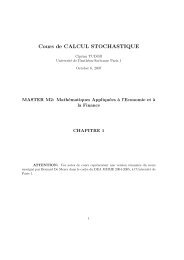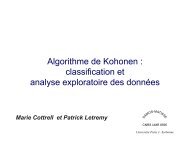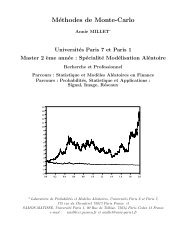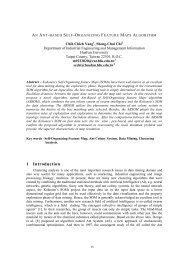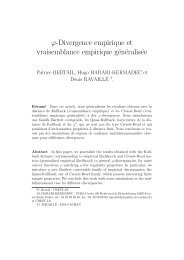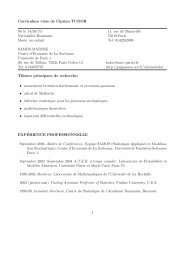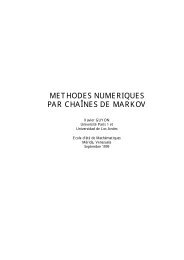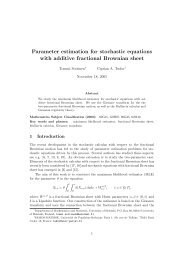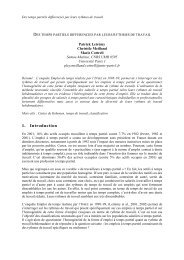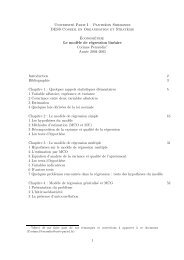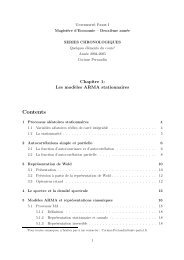Fast vector quantization with topology learning
Fast vector quantization with topology learning
Fast vector quantization with topology learning
Create successful ePaper yourself
Turn your PDF publications into a flip-book with our unique Google optimized e-Paper software.
FAST VECTOR QUANTIZATION WITH TOPOLOGY LEARNING<br />
Marcos M. Campos<br />
Oracle<br />
Data Mining Technologies<br />
Burlington, USA<br />
marcos.m.campos@oracle.com<br />
Abstract – A new <strong>vector</strong> <strong>quantization</strong> algorithm is introduced that is capable of <strong>learning</strong> the<br />
<strong>topology</strong> of the input distribution. The algorithm uses a tree-structured <strong>vector</strong> quantizer<br />
combined <strong>with</strong> <strong>topology</strong> <strong>learning</strong> to achieve fast performance and high accuracy. The<br />
approach can be applied to improve the performance of different types of tree-structured<br />
<strong>vector</strong> quantizers. This is illustrated <strong>with</strong> results for k-d trees and TSVQ on two highdimensional<br />
datasets. The proposed method also allows the construction of <strong>topology</strong>preserving<br />
graphs <strong>with</strong> one node per input row. The algorithm can be used for <strong>vector</strong><br />
<strong>quantization</strong>, clustering, indexing, and link analysis.<br />
Key words – <strong>vector</strong> <strong>quantization</strong>, <strong>topology</strong> <strong>learning</strong>, constructive self-organizing maps,<br />
clustering, indexing, approximate nearest-neighbor search, unsupervised <strong>learning</strong><br />
1 Introduction<br />
The problem of <strong>topology</strong> <strong>learning</strong> can be defined as: given some high-dimensional data<br />
distribution, find a topological structure that closely captures the <strong>topology</strong> of the data<br />
distribution [10]. This problem is closely related to the problem of <strong>learning</strong> a graph that<br />
captures the topological relationships in the data. The goal in <strong>topology</strong> <strong>learning</strong> contrasts <strong>with</strong><br />
that of methods such as Self-Organizing Map (SOM) [13], Growing Cell Structure [9],<br />
Growing Hierarchical Self-Organizing Map [7], and ISOMAP [16] where the <strong>topology</strong> of the<br />
output space is fixed beforehand. These other methods are mainly concerned <strong>with</strong><br />
dimensionality reduction. The mappings from the original space to the new space produced by<br />
projection methods frequently have topological defects. That is, neighboring points in input<br />
spaces may be mapped to far away points in the output or transformed space. Projection<br />
methods, however, are especially useful for representing multidimensional data in a form that<br />
can be visually inspected.<br />
Learning a topological representation (graph) of a dataset can be used for <strong>vector</strong> <strong>quantization</strong>,<br />
clustering, link analysis, and indexing for nearest-neighbor and approximate nearest-neighbor<br />
searches. Several algorithms have been proposed for <strong>learning</strong> general topologies. These can be<br />
broadly classified into static (e.g., Neural Gas (NG) [15], and Optimally Topology Preserving<br />
Maps (OTPMS) [3]) and constructive architectures (e.g., Growing Neural Gas (GNG) [10], and<br />
SAM-SOM [6]). These algorithms can be seen as attempts to overcome the limitations in the<br />
SOM algorithm, including: fixed pre-defined output space <strong>topology</strong> (SOM uses a regular grid),<br />
poor scalability for large topologies, slow <strong>learning</strong>, and hard to tune parameters. All these
WSOM 2005, Paris<br />
methods create topological structures that are more flexible than SOM and thus better capture<br />
the topological relationships in the input data distribution. Constructive approaches speed up<br />
<strong>learning</strong> by leveraging hierarchical structures and growing the structure on demand. While<br />
most constructive methods use specialized data structures for speeding up <strong>learning</strong>, SAM-SOM<br />
proposes a different approach. It takes advantage of off-the-shelve hierarchical indexing<br />
methods to scale to large datasets and number of dimensions. This innovative proposal<br />
eliminates the need to develop specialized data structures for speeding up the search for the<br />
best matching unit (BMU), a key operation in <strong>topology</strong> <strong>learning</strong> algorithms.<br />
Topology-<strong>learning</strong> algorithms usually attempt to learn the <strong>topology</strong> online. As a result, these<br />
algorithms require slow adaptation to the data. With few exceptions (e.g., GNG and SAM-<br />
SOM), online <strong>learning</strong> algorithms use multiple decaying parameters, which lead to relatively<br />
slow training. SAM-SOM is the only algorithm that attempts to learn a topological structure<br />
<strong>with</strong> a node for each input data <strong>vector</strong>. The algorithm use simple rules for creating and pruning<br />
connections. It is not clear, however, that these simple rules can approximate well the <strong>topology</strong><br />
of input data distributions <strong>with</strong> uneven density and different dimensionalities in different areas<br />
of the input space.<br />
Vector <strong>quantization</strong> is a lossy compression technique that uses a codebook for encoding and<br />
decoding data. Vector <strong>quantization</strong> techniques are aimed at creating small codebooks capable<br />
of encoding and decoding data <strong>with</strong> the smallest possible difference between original and<br />
reconstructed data. Vector <strong>quantization</strong> can also be seen as a special case of clustering. As in<br />
clustering, many data records are mapped to a single code<strong>vector</strong> or cluster. Some applications<br />
of <strong>vector</strong> <strong>quantization</strong> include speech and image compression.<br />
Vector quantizers for high dimensional <strong>vector</strong> spaces need a large codebook to achieve a small<br />
error rate. The Tree-Structured Vector Quantizer (TSVQ) [11] is a popular technique that<br />
scales well for large datasets and codebook sizes. Different versions of k-d trees have also been<br />
proposed for fast <strong>vector</strong> <strong>quantization</strong> [1]. k-d trees produce encoders <strong>with</strong> smaller memory<br />
footprint and faster encoding than TSVQ but, in general, they require larger codebooks for<br />
achieving the same level of compression of TSVQ.<br />
As the size of the tree (codebook) grows the ability of approaches such as TSVQ and k-d trees<br />
to return the actual nearest neighbor to a input <strong>vector</strong> decreases. That is, the closest code<strong>vector</strong><br />
(leaf centroid) to a given input may not be the one where the input is mapped to by the tree.<br />
The problem becomes more accentuated in axis-parallel approaches like k-d tree, where the<br />
partition imposed by the tree at each point is not well aligned <strong>with</strong> the data distribution<br />
principal directions. In general, tree-structured approaches trade speed for higher <strong>quantization</strong><br />
error for a fixed codebook size when compared <strong>with</strong> full search approaches such as the LBG<br />
algorithm [11]. Some approaches have tried to minimize the impact of the error in the tree<br />
assignments by searching multiple paths at the same time [2, 4, 5] or by exploring a learned<br />
topological structure to search near-nodes for a better match [1, 7, 14]. Arya and Mount [1]<br />
have shown that the latter requires significantly less computation than the standard k-d tree<br />
approach for achieving the same level of error. Unfortunately, for a dataset <strong>with</strong> N input<br />
<strong>vector</strong>s, the RNG* algorithm used in [1] scales <strong>with</strong> O(N 2 ), making it unsuitable for large<br />
datasets.<br />
This paper proposes a new algorithm called a <strong>vector</strong> approximation graph (VA-graph) that<br />
leverages a tree based <strong>vector</strong> quantizer to quickly learn the topological structure of the data. It<br />
then uses the learned <strong>topology</strong> to enhance the performance of the <strong>vector</strong> quantizer. VA-graph<br />
can also learn graphs <strong>with</strong> as many nodes as the number of input <strong>vector</strong>s. Due to space<br />
constraints, the algorithm is presented in a batch version only. The paper is divided in 5<br />
sections. Section 2 presents the tree construction step in VA-graph. Section 3 describes the
<strong>Fast</strong> Vector Quantization <strong>with</strong> Topology Learning<br />
<strong>topology</strong> <strong>learning</strong> capabilities. Section 4 reports the results for <strong>vector</strong> <strong>quantization</strong><br />
experiments. Section 5 presents the conclusions and directions for future work.<br />
2 Building the Tree<br />
VA-graph combines a tree-structured <strong>vector</strong> quantizer <strong>with</strong> a fast <strong>topology</strong>-<strong>learning</strong> algorithm<br />
that relies on the tree-structured quantizer for its speed and scalability. The <strong>vector</strong> quantizer<br />
leverages the learned <strong>topology</strong> of the input data to achieve improved accuracy. The algorithm<br />
has three main pieces: tree construction, <strong>topology</strong> <strong>learning</strong>, and search or encoding. This<br />
section introduces the basic data partition scheme used in VA-graph for constructing the tree.<br />
Figure 1: Tree building steps.<br />
The algorithm builds a tree recursively as described in Figure 1. The algorithm is initialized<br />
<strong>with</strong> a single root node. The centroid of the root node is set to the mean of the data and the<br />
number of leaves (k 0 ) is set to 1. If the number of leaves is smaller than desired codebook size<br />
(k) then the eligible leaf node <strong>with</strong> the largest cost measure value is selected for splitting.<br />
Eligible leaf nodes are those <strong>with</strong> at least n data <strong>vector</strong>s assigned to them. If no leaf node is<br />
eligible for splitting the algorithm terminates. Some common cost measures are: the mean<br />
<strong>quantization</strong> error associated <strong>with</strong> the node and the number of input <strong>vector</strong>s assigned to the<br />
node. The experiments in this paper used the mean <strong>quantization</strong> error.<br />
The leaf splitting step varies according to the type of <strong>vector</strong> quantizer implemented. TSVQ<br />
uses a 2-means approach for computing the centroids of the two child nodes and for assigning<br />
data to the child nodes. A k-d tree, on the other hand, uses axis parallel splits. In the k-d tree<br />
implemented here, the mean value of the node’s component <strong>with</strong> the largest variance is used to<br />
split the node. After a leaf is split, k 0 is incremented by one.<br />
The above tree building procedure is O(mNlog 2 k), where N is the number of input <strong>vector</strong>s, m is<br />
the number of dimensions in an input <strong>vector</strong>, and k is the maximum or desired codebook size<br />
(number of leaves in the tree).<br />
3 Learning the Topology<br />
The topological structure of the input data distribution can be learned as a post-processing step<br />
to the tree building stage. The method proposed here can be seen as a hierarchical extension of<br />
OTPMS [3]. The OTPMS algorithm works as follows: Given a codebook of size k, constructed<br />
by a <strong>vector</strong> quantizer, for each input <strong>vector</strong> find the two nearest code<strong>vector</strong>s to the input and<br />
link them. OTPMS is optimum <strong>with</strong> respect to some of the most commonly used measures of<br />
topological quality [3]. However, it requires O(Nkm) computations and does not scale well for<br />
large codebooks. If k ~ N it requires O(N 2 m) processing. In order to mitigate this, it is proposed<br />
here the use of a hierarchical <strong>vector</strong> quantizer to help speed up the computation of the 2-NN
WSOM 2005, Paris<br />
problem, that is, finding the two nearest codewords for each input <strong>vector</strong>. Although there are<br />
many different and efficient approaches to speed up nearest neighbor queries [1], for the<br />
experiments in this paper a simple strategy was used: For each row go down the tree using at<br />
most p paths and then connect the two leaves closest to the input <strong>vector</strong>. This procedure is<br />
O(Nmplog 2 k). For k ~ N it becomes O(Nmplog 2 N). A value of p less than 10 seems to work<br />
well for reasonably large codebook sizes. In practice, p equal 4 or 5 produced good results for<br />
codebook sizes <strong>with</strong> a couple of thousand code<strong>vector</strong>s.<br />
Applications such as link analysis and nearest neighbor queries may require the creation of<br />
topological structures where k ~ N. For these cases, there are not enough data per leaf node for<br />
OTPMS to capture the structure of the manifold containing the input <strong>vector</strong>s. This problem is<br />
shared by most <strong>topology</strong> <strong>learning</strong> algorithms. In order to address this we propose a strategy<br />
based on the following ideas: generate random data constrained to small volumes of the input<br />
space following the local shape of the manifold containing the data, and use the <strong>topology</strong> at<br />
higher layers of the tree as a guide for the <strong>topology</strong> at lower layers. The random sampling is<br />
used to learn local relationships in the spirit of OTPMS. If the sample is constrained to the<br />
ranges in the centroids of the nodes in the subtree of a given baseline graph node, it is expected<br />
that the sampling will be contained on a hyper-rectangle <strong>with</strong> dimensions adapted to the local<br />
shape of the manifold containing the data. The use of the topological connections at the higher<br />
layers of the tree as guides to the connectivity at lower levels can be seen as a smoothing or<br />
regularizing effect that compensates for the small sample size and help learn the overall<br />
structure. The following steps are proposed for extending the algorithm to cases where k ~ N:<br />
1. Create baseline graph: Identify a level of <strong>quantization</strong> in the tree structure quantizer<br />
for which the nodes have enough support to capture well the <strong>topology</strong> of the data.<br />
This can be accomplished by selecting all nodes in the tree where C j < n and C d(j) ≥<br />
n, where C j is the number of inputs assigned to node j, d(j) is one of the indices of<br />
node j two children, and n is a user defined parameter. Apply OTPMS to this set of<br />
nodes to construct a baseline graph. Utilize the tree structure for speeding up the 2-<br />
NN search. In this paper, the multi-path approach is used in all the experiments.<br />
This is a O(Nmplog 2 k b ) operation, where k b is the number of nodes in the baseline<br />
graph. This step is quite robust to the value used for the parameter n. In practice n<br />
as low as 10 produced good results.<br />
2. Link subtree: For each j node in the baseline graph generate r random <strong>vector</strong>s. The<br />
components of the random <strong>vector</strong>s should be between the minimum and the<br />
maximum values found for these components in the leaf nodes in the subtree rooted<br />
at the respective baseline graph node. Combine the r random <strong>vector</strong>s <strong>with</strong> the<br />
centroid values for the leaf nodes in the subtree. For each row in the combined set<br />
find the 2-NN leaf nodes s 1 and s 2 in the subtree and link them. Assign a weight of<br />
1/dist(s 1 , s 2 ) to the link, where dist(a, b) is a distance function (usually the<br />
Euclidean metric can be used). This is a O(k b mprlog 2 n) operation. For r ~ n and k b<br />
~ N/n then it becomes a O(Nmplog 2 n) operation.<br />
3. Create long-range links: For each pair of nodes (u 1 , u 2 ) connected by a link in the<br />
baseline graph and for each leaf s 1 in the subtree rooted in u 1 , find the closest leaf<br />
node s 2 in the subtree rooted in u 2 . If 1/dist(s 1 , s 2 ) is greater than the smallest weight<br />
amongst the links containing either s 1 or s 2 then create a link between s 1 and s 2 . If s 2<br />
was already linked to a node in the subtree rooted at u 1 then keep the link <strong>with</strong> the<br />
smallest weight. This is a O(0.5k b nmpllog 2 n) operation, where l is the average<br />
number of links for nodes in the baseline graph. For k b ~ N/n it becomes<br />
O(0.5Nmpllog 2 n)
<strong>Fast</strong> Vector Quantization <strong>with</strong> Topology Learning<br />
The approach proposed above takes three parameters: p, n, and r. In practice, setting r = n<br />
works well and eliminates the need of a free parameter.<br />
The ability of VA-graph to learn the <strong>topology</strong> of the input distribution using the algorithm<br />
described above is illustrated in Figures 2 and 3. k-d tree was the <strong>vector</strong> quantizer used in these<br />
examples. Figure 2 shows, for k
WSOM 2005, Paris<br />
Once a <strong>topology</strong> has been learned it can be used to enhance the search for the BMU in the tree<br />
<strong>vector</strong> quantizer. The search process on the neighborhood graph follows the approach in [1].<br />
Search is accomplished in two steps. First, the tree is traversed (single path) until a leaf is<br />
reached. Next, the nearest neighbors in the graph to the leaf node are visited to determined if a<br />
better codebook can be found. The best matching node is selected for further expansion, in<br />
which case its nearest neighbors in the graph are visited. The search through the graph is halted<br />
after a certain number of nodes have been visited or a given number of expansions s has taken<br />
place. The second stopping criterion is the one used in the experiment section of the paper. The<br />
processing for this approach is O(Nmlog 2 N + Nms) for TSVQ and O(Nlog 2 N + Nms) for k-d<br />
tree.<br />
4 Experiments<br />
This section illustrates the performance of VA-graph on two <strong>vector</strong> <strong>quantization</strong> experiments.<br />
The experiments used the Letters and the Corel Image Features datasets from the UCI Machine<br />
Learning Archive 1 and UCI KDD Archive 2 respectively. For all the results below, the<br />
following labels were used: k-d tree represents a tree search for a k-d tree quantizer, TSVQ<br />
describes a tree search using a TSVQ quantizer, FS indicates a full search over the codebook<br />
produced by either tree quantizer (k-d tree or TSVQ), VA-g represents results for a <strong>topology</strong><br />
learned using the multi-path algorithm described in Section 3 (p = 4, n = 10, r = 0, and s = 1),<br />
VA-gO indicates results using a <strong>topology</strong> learned <strong>with</strong> OTPMS. The full search case (FS) is<br />
the smallest <strong>quantization</strong> error possible for the codebook created by the <strong>vector</strong> quantizers in the<br />
experiments. The <strong>topology</strong> for the VA-gO results is the optimal <strong>topology</strong> that can be learned for a<br />
particular experiment given the codebook produced by the tree quantizer used in the experiment.<br />
The Letters dataset has 20,986 rows and 17 attributes. Figure 4 shows the distortion (SSE,<br />
Sum of Squared Errors) for two sets of studies for different codebook sizes. In the first study, a<br />
k-d tree was used as the <strong>vector</strong> quantizer. In the second, TSVQ was used as the <strong>vector</strong><br />
quantizer. The graphs clearly illustrate the benefit of using VA-graph <strong>with</strong> the topological<br />
information. In the experiments, the results for the approximated <strong>topology</strong> using the simple<br />
multi-path method are very close to those for the optimal <strong>topology</strong>. In addition, the<br />
performance of the quantizers leveraging the topological structure approaches that of the full<br />
search for both the k-d tree and TSVQ even for s = 1. Finally, although not reported in the<br />
graphs, the average number of extra nodes searched by VA-graph is at most 13 across all<br />
codebook sizes and <strong>vector</strong> quantizers in this set of experiments. To place this in perspective,<br />
for a codebook size of 256, VA-graph would search on average 13 + log 2 256 = 21 nodes versus<br />
8 nodes for the basic <strong>vector</strong> quantizers and 256 for the full search case.<br />
For the second experiment a subset <strong>with</strong> 20,000 rows and 89 attributes of the Corel dataset was<br />
used. The results, illustrated in Figure 5, follow the same trends seen for the Letters dataset.<br />
Again, the average number of extra nodes searched by VA-graph is at most 13 across all<br />
codebook sizes and <strong>vector</strong> quantizers used <strong>with</strong> the Corel dataset. Furthermore, for a codebook<br />
size of 1024, 97.8% (k-d tree case) and 99.7% (TSVQ case) of the nearest neighbor<br />
code<strong>vector</strong>s were <strong>with</strong>in four hops from the leaf selected by the basic quantizers. For smaller<br />
codebook sizes, a higher percentage of the nearest neighbor code<strong>vector</strong>s were <strong>with</strong>in fewer<br />
hops from the initial leaf node.<br />
1 http://www.ics.uci.edu/~mlearn/MLRepository.html<br />
2<br />
http://kdd.ics.uci.edu/
<strong>Fast</strong> Vector Quantization <strong>with</strong> Topology Learning<br />
Figure 4: Sum of Squared Errors (SSE) as a function of codebook size for the Letters dataset. Left chart: k-d tree was<br />
used as the <strong>vector</strong> quantizer. Right chart: TSVQ was used as the <strong>vector</strong> quantizer.<br />
Figure 5: Sum of Squared Errors (SSE) as a function of codebook size for the Corel dataset. Left chart: k-d tree was used<br />
as the <strong>vector</strong> quantizer. Right chart: TSVQ was used as the <strong>vector</strong> quantizer.<br />
It should be noted that it is possible to improve the performance of VA-graph by expanding the<br />
search in the graph to include more nodes (s > 1).<br />
5 Conclusions<br />
This paper introduced VA-graph, a new <strong>vector</strong> <strong>quantization</strong> algorithm that is capable of <strong>learning</strong><br />
the <strong>topology</strong> of the input distribution. The approach presented here can be easily adapted for<br />
<strong>learning</strong> topologies using other hierarchical structures. The random sampling method discussed in<br />
Section 3 can be used to allow other <strong>topology</strong> <strong>learning</strong> algorithms to learn graphs <strong>with</strong> one node<br />
per input row.<br />
VA-graph is also a promising algorithm for use in an indexing system. Scalar and <strong>vector</strong><br />
<strong>quantization</strong> approaches have gained attention during the last years as an approach for indexing<br />
high dimensional <strong>vector</strong> spaces for exact and approximate similarity queries [8].
WSOM 2005, Paris<br />
The current work can be expanded in a couple of directions, including: an online version of the<br />
algorithm, exploration of indexing applications, use of alternative nearest neighbor searching<br />
strategies in the tree [1, 2] in place of the multi-path approach, and applications to link<br />
analysis, data projection, and clustering.<br />
References<br />
1. S. Arya and D. M. Mount (1993), Algorithms for fast <strong>vector</strong> <strong>quantization</strong>. In J. A. Storer and<br />
M. Cohn, editors, Proceedings of DCC 93: Data Compression Conference, p. 381-390, IEEE<br />
Press.<br />
2. S. Bader, F. Maire, and F. Wathne (2004), <strong>Fast</strong> indexing of codebook <strong>vector</strong>s using dynamic<br />
binary search trees <strong>with</strong> fat decision hyperplanes, Studies in Fuzziness and Soft Computing,<br />
vol. 152, Springer.<br />
3. J. Bruske and G. Sommer (1997), Topology representing networks for intrinsic dimensionality<br />
estimation, ICANN, p. 595-600.<br />
4. M. Campos and G. Carpenter (2001), S-TREE: Self-organizing trees for data clustering and<br />
online <strong>vector</strong> <strong>quantization</strong>, Neural Networks, vol. 14, p. 505-525.<br />
5. C-C. Chang and T. S. Chen (1997), New trees-structured <strong>vector</strong> <strong>quantization</strong> <strong>with</strong> closestcoupled<br />
multipath searching method, Optical Engineering, vol. 36, p. 1713-1720.<br />
6. E. Cuadros-Vargas and R. F. Romero (2002), A SAM-SOM family: Incorporating spatial<br />
access methods into constructive self-organizing maps. In Proceedings IJCNN’02, Intl. Joint<br />
Conference on Neural Networks, p.1172-1177, IEEE Press.<br />
7. M. Dittenbach, A. Rauber, and D. Merkl (2001), Recent advances <strong>with</strong> the growing<br />
hierarchical self-organizing map. In N. Allinson, H. Yin, L Allinson, J. Slack, editors,<br />
Advances in Self-Organizing Maps: Proceedings of the 3rd Workshop on Self-Organizing<br />
Maps, Lincoln, England, Springer.<br />
8. H. Ferhatosmanoglu and E. Tuncel (2000), Vector approximation based indexing for nonuniform<br />
high dimensional data sets. In Proceedings of the Ninth International Conference on<br />
Information and Knowledge Management, Virginia, United States, p. 202-209.<br />
9. B. Fritzke (1994), Growing cell structures – A self-organizing network for unsupervised and<br />
supervised <strong>learning</strong>, Neural Networks, vol. 7, p.1441-1460.<br />
10. B. Fritzke (1995), A growing neural gas network learns topologies. In G. Tesauro, D. S.<br />
Touretzky, and T. K. Leen, editors, Advances in Neural Information Processing Systems 7, p.<br />
625-632, MIT Press, Cambridge MA.<br />
11. A. Gersho and R. Gray (1992), Vector Quantization and Signal Processing, Kluwer Academic<br />
Publisher.<br />
12. K. Kiviluoto (1996), Topology preservation in self-organizing maps. In Proceedings of<br />
ICNN’96, International Conference on Neural Networks, vol. 1, p. 294-299, IEEE Neural<br />
Networks Council.<br />
13. T. Kohonen (1982), Self-organized formation of topologically correct feature maps, Biological<br />
Cybernetics, vol. 43, p. 59-69.<br />
14. P. Koikkalainen (1994), Progress <strong>with</strong> the tree-structured self-organizing map. In Proceedings<br />
ECAI’94, 11 th European Conference on Artificial Intelligence, p. 211-215.<br />
15. T. Martinez and K. Schulten (1993), A “neural gas” network learns topologies. In T. Kohonen,<br />
K. Makisara, O. Simula, and J. Kangas, editors, Artificial Neural Networks, vol. 7(3), p. 507-<br />
522.<br />
16. J. Tenenbaum, V. de Silva, and J. Langford (2000), A global geometric framework for<br />
nonlinear dimensionality reduction, Science, vol. 22, p. 2319-2323.



